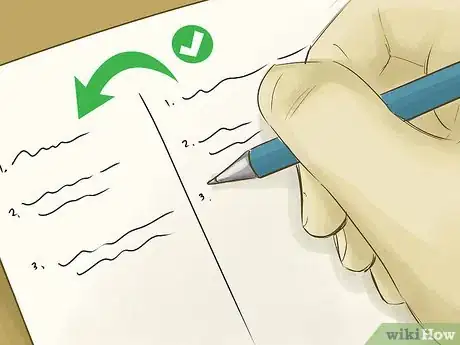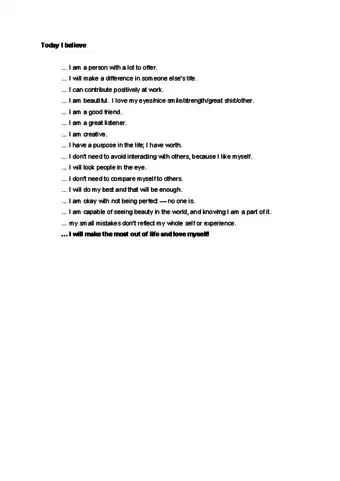This article was co-authored by Michael Stern. Michael Stern is a life coach and the owner of Integral Alignment, a coaching and training business focused on a holistic approach to optimizing one's health, work, love, play, and spirituality. Michael began his professional training in 2011 as an Integral Spiritual Mentor through One Spirit Learning Alliance, and has been certified as both a hatha yoga instructor and an Emotional Intelligence Coach through GolemanEI. In addition to his private 1:1 and groupwork, he has hosted workshops with thought leaders such as Frederic Laloux, Charles Eisenstein, and Thomas Hübl. Michael holds a BA in Spanish Language from Vanderbilt University and lives in Portland, Maine.
There are 12 references cited in this article, which can be found at the bottom of the page.
wikiHow marks an article as reader-approved once it receives enough positive feedback. In this case, 100% of readers who voted found the article helpful, earning it our reader-approved status.
This article has been viewed 397,432 times.
Affirmations can help take your world from negative to positive in just a few minutes a day. These short sayings are positive statements that keep you motivated and help you develop better self-esteem. They can be used to change negative thoughts and also to motivate you to accomplish your goals. The best part? It's incredibly easy to get started. Keep reading to learn how you can start using affirmations to change your life for the better.
Steps
Fighting Negative Thinking
-
1Make a list of the negative thoughts you want to dismiss. Affirmations can be useful in turning your negative thoughts into positives. To effectively counter those thoughts, though, you need to first identify them. Start by writing out a list of the negative thoughts you want to work on dismissing using positive affirmations.[1]
- For example, if you constantly tell yourself that you are ugly and worthless, two negative thoughts worth writing down would be, “I think I don’t contribute to the world around me,” and “I am not happy with my appearance.”
- Write down as many negative thoughts as you feel comfortable bringing up. Right now, you are just brainstorming things you may want to address.
- Negative affirmations are typically rooted in a distorted view of reality, so positive affirmations will be rooted in a more objective truth.[2]
-
2Prioritize your list to identify what you want to work on. Once you’ve finished your list of negative thoughts, think about which ones impact you most in your daily life. To get the most out of your affirmations, you’ll want to focus on one or two pieces of negative self-talk at a time. Use your list to help you decide which negative thoughts you want to get rid of the most.[3]
- It can be tempting to try to conquer all your negative thoughts. Ultimately, though, you will have more success if you start with just one or two and work your way up.
- Try writing down whatever negative thoughts you have every day. After a week or 2, look at this journal to see what types of concerns or criticisms you keep having. These repeat thoughts should probably be a priority to fix.
Advertisement -
3Write a counter-argument to your negative thought. After you’ve picked out the piece of negative self-talk on which you want to focus, write a counter-argument for it. Provide yourself with evidence that counters your negative thought, and affirm how this evidence makes you feel about yourself. This will provide the basis for your affirmation.[4]
- For example, if you are trying to counter the thought that you are not very smart, you could write, “I know how to design a program from the ground up and this makes me feel capable and intelligent.”
- Don’t lie to yourself in your counter-arguments. If you’re not great at math, for example, don’t tell yourself that you are. The most effective counter-arguments will be the ones rooted in truth. Draw from all the amazing skills and experiences you already have.[5]
- Don't be overly positive in your affirmations, at least not at first. In fact, you are better off using neutral counterarguments rather than positive ones when you first begin. Over time, you can start to become more optimistic.
-
4Create your affirmation using your counter-argument. Using your counter-argument as guidance, write out your affirmation. Your affirmation should identify yourself in a positive light and frame you as the kind of person you value. It should also use the feelings you identified in your counter-argument to support yourself and verify why you're worth your while.[6]
- For example, a college student who feels unintelligent may say, “I am an intelligent, capable student who is on their way to graduating.” Someone struggling with depression may write, “I am a loving, caring person who deserves to be happy.”
-
5Repeat your affirmation daily for at least 5 minutes. Take at least 5 minutes every day to say your affirmation to yourself over and over. If you can, look at yourself directly in the mirror and say your affirmation out loud during this time. It’s going to feel uncomfortable at first, but affirmations only work through repetition. Sometimes you just have to adopt a "fake it 'til you make it" mentality.[7]
- Continue this process for as long as you need to counteract your negative thought. For some people, this may be a matter of several weeks. For others, it could take months or even years.
- Your affirmation will slowly force your brain to confront the disconnect between what you are saying and how you see yourself. Repeating your affirmation helps retrain your brain to stop feeling so uncomfortable when you think positively about yourself.[8]
Visualizing Positive Outcomes
-
1Set your desired goal or outcome. Your affirmation will work best when it targets a specific goal or outcome. Your goal may be ongoing, such as being more confident or getting ahead in your career. It could also have a set deadline, such as finishing a project on time or being ready for a big event.[9]
- Picking an outcome will help you target your affirmation and give it real applications in your daily life.
- Give yourself enough time to reach your goal or to develop a new habit. It can take around 66 days to form a new habit or to change an old one.[10]
- Affirmations are helpful to begin rewiring your brain to think more positively, but you need to support that process with behavior that further reinforces the truthfulness of your positive affirmations.[11]
-
2Write out your positive attributes. We rarely focus on what we like about ourselves, but our strengths are hugely important in accomplishing our goals. An inventory of your positive traits will help you see all your personal strengths. Write down a list of all your positive attributes to help guide your affirmation.[12]
- Take stock of yourself by making an inventory of your best qualities, abilities, or other attributes: Are you gorgeous? Write it down. Are you a hard worker? Make note of it.
- Make your sentences short, first-person statements such as "I am generous," for example, or "I can speak 4 languages.”
- If you are struggling to think of positive things, challenge yourself to write at least 5 positives to start. You may find that once you get going, you’re more comfortable with the activity.
- Try asking someone else for their opinion on what your positive attributes are. They may identify characteristics that you haven't noticed about yourself.
-
3Match up some of your positive attributes with your goals. Ask yourself which of your positive qualities will help you achieve the goals or reach the outcome you want. If you're quitting smoking, for example, you may draw upon your willpower or courage. If you are trying to pass a class, you may want to focus more on your determination and intelligence.[13]
-
4Write out your affirmation using your positive attributes. Once you know what attributes will help you reach your goal, write out your affirmation. Make it action-oriented by affirming that you will accomplish your goal. Then list the positive attributes that will help you achieve your goal.[14]
- For example, if you are trying to quit smoking, let yourself know, “I will stop smoking because I am strong, I am determined, and I am worth the effort.” If you are looking for a promotion, try, “I will get my promotion because I am an experienced, capable Project Manager.”
-
5Say your affirmation every day for at least 5 minutes. For your affirmation to work, you need to expose yourself to it every day. Stand in front of the mirror and say your affirmation out loud over and over again for at least minutes. The more you say your affirmation, the more you are encouraging your brain to visualize your positive outcome. [15]
- If you can take 5 minutes twice a day to say your affirmation, that’s even better.
Getting the Most from Affirmations
-
1Use your affirmations as a guide for change. Affirmations can be a powerful self-help tool, but just saying them is only part of the process. Affirmations need to be coupled with action in order to be truly effective. Use your affirmation as a guide for the change you want to bring about in your life. Then, take actions to pursue that change.[16]
- If you want that promotion, make an affirmation letting yourself know you’re worthy. Then, update your resume, put together a strong proposal, and let your boss know. Your affirmation will help you see that you are capable, and your actions will get the job done.
- Use your affirmation as a reminder of the fact that you can be the person you want to be. It should highlight some of your best traits. Reflect on those when things get tough.
-
2Write out your affirmations in addition to saying them. In addition to saying your affirmations every day, write them out when you have a moment. This provides different mental feedback than saying your affirmations, which may help to further reinforce your goals and strengths. It's also a good way to use your affirmation at places like work or school when you need it, but don't want others to hear it.[17]
- You could decide that you want to write out your affirmation a certain number of times, such as at least 10 times before you go to bed.
- Post your affirmations in areas where you will see them often. Put one on your desk, mirror, car dashboard, or computer. Slip one into your wallet or carry a small notebook with you.
- Alternatively, you may decide that you only want to write it out when you are feeling especially stressed or upset.
-
3Meditate on your affirmations. Close your eyes, breathe deeply, try to shut out the rest of the world, and think about your affirmations. Slowly and calmly repeat the words, thinking about what each one means to you. Visualize the positive feelings you want to create or the goals you want to achieve each time you say your affirmation.
- If you are new to meditation, start by taking a few slow, deep breaths and trying to clear your mind. You probably won’t get all the noise out your first few times, and that’s alright. The simple act of trying can still have positive effects.
-
4Post your affirmation in important places. Use note cards, sticky notes, a cute poster or printout, or any other system you like to write out your affirmation. Leave these notes in places where you will not only see them, but need to be reminded of your affirmation. Try to think of places where you frequently experience stress or self-doubt, and put a copy of your affirmation there.[18]
- Slip one inside your desk drawer, or stick one to your computer monitor. Put one up on the bathroom mirror, and stick one on the refrigerator. Each time you see the card, read it and think about what it means to you.
- Carry your affirmation with you, too. Put a copy of your affirmation in your wallet or purse. If you need a pick-me-up, or if you find yourself about to waver from your goals, get it out and repeat it to yourself.
Effective Affirmations Examples
Expert Q&A
-
QuestionHow do I use self-affirmations?
 Michael SternMichael Stern is a life coach and the owner of Integral Alignment, a coaching and training business focused on a holistic approach to optimizing one's health, work, love, play, and spirituality. Michael began his professional training in 2011 as an Integral Spiritual Mentor through One Spirit Learning Alliance, and has been certified as both a hatha yoga instructor and an Emotional Intelligence Coach through GolemanEI. In addition to his private 1:1 and groupwork, he has hosted workshops with thought leaders such as Frederic Laloux, Charles Eisenstein, and Thomas Hübl. Michael holds a BA in Spanish Language from Vanderbilt University and lives in Portland, Maine.
Michael SternMichael Stern is a life coach and the owner of Integral Alignment, a coaching and training business focused on a holistic approach to optimizing one's health, work, love, play, and spirituality. Michael began his professional training in 2011 as an Integral Spiritual Mentor through One Spirit Learning Alliance, and has been certified as both a hatha yoga instructor and an Emotional Intelligence Coach through GolemanEI. In addition to his private 1:1 and groupwork, he has hosted workshops with thought leaders such as Frederic Laloux, Charles Eisenstein, and Thomas Hübl. Michael holds a BA in Spanish Language from Vanderbilt University and lives in Portland, Maine.
Life Coach Support your self-affirmations with behaviors further reinforcing those positive affirmations. If you don't attempt to change your behavior, your subconscious will latch onto the disconnect between what you're saying and reality. If you let affirmations guide you to insights on how you want to behave and really start acting that way, your mind and body will become more coherent.
Support your self-affirmations with behaviors further reinforcing those positive affirmations. If you don't attempt to change your behavior, your subconscious will latch onto the disconnect between what you're saying and reality. If you let affirmations guide you to insights on how you want to behave and really start acting that way, your mind and body will become more coherent.
References
- ↑ https://tinybuddha.com/blog/how-to-change-your-mind-and-your-life-by-using-affirmations/
- ↑ Michael Stern. Life Coach. Expert Interview. 1 July 2020.
- ↑ https://tinybuddha.com/blog/how-to-change-your-mind-and-your-life-by-using-affirmations/
- ↑ https://www.2knowmyself.com/affirmations/How_to_use_affirmations_effectively_and_successfully
- ↑ Michael Stern. Life Coach. Expert Interview. 1 July 2020.
- ↑ https://spiritualityhealth.com/blogs/real-love-with-eve/2011/12/30/eve-hogan-affirmations-why-they-work-how-use-them
- ↑ https://www.the-guided-meditation-site.com/how-to-use-affirmations.html
- ↑ https://www.ncbi.nlm.nih.gov/pubmed/11413947
- ↑ https://www.goodtherapy.org/blog/how-positive-affirmations-can-help-you-achieve-your-goals-0227175
- ↑ http://www.ucl.ac.uk/news/news-articles/0908/09080401
- ↑ Michael Stern. Life Coach. Expert Interview. 1 July 2020.
- ↑ https://tinybuddha.com/blog/how-to-change-your-mind-and-your-life-by-using-affirmations/
- ↑ https://www.healthyplace.com/self-help/anxiety/use-these-positive-affirmations-for-anxiety-relief/
- ↑ https://www.healthyplace.com/self-help/anxiety/use-these-positive-affirmations-for-anxiety-relief/
- ↑ https://www.the-guided-meditation-site.com/how-to-use-affirmations.html
- ↑ https://coachcampus.com/coach-portfolios/research-papers/stania-zbela-towards-effective-use-of-positive-affirmations-in-coaching/
- ↑ https://www.successconsciousness.com/affirmations_self_talk.htm
- ↑ https://www.powerofpositivity.com/24-affirmations-help-build-positive-self-talk/
About This Article
To use affirmations effectively, first identify the most common negative thoughts you have about yourself, like, "I'm not attractive," "I'm a failure," or "I'm not smart enough." Then, choose 1 or 2 of your negative thoughts that impact you the most on a daily basis. Stick with just 1 or 2 thoughts at first since it will be more effective than trying to tackle all of your negative thoughts at once. Next, come up with a counter-argument to each negative thought, like, "I've succeeded at many things in my life, and I can be successful if I work hard" or "I'm an intelligent, capable person who deserves to be happy." Once you have your counter-arguments, repeat them as affirmations every day for at least 5 minutes. Over time, when you start feeling better about yourself, you can move on to new negative thoughts that you want to overcome. For advice from our Counselor co-author, like how to meditate on your affirmations, keep reading!












































































